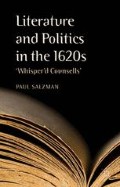Abstract
The most remarkable engagement with political ideas by a literary genre occurred within the romance, where, in the 1620s, two prose romances in particular built upon earlier models to develop a sophisticated intervention in current affairs. The most prominent Elizabethan example of the genre, Philip Sidney’s Arcadia, had a much greater presence in the 1620s than its ‘parallel’ in verse, Spenser’s Faerie Queene. As numerous scholars have outlined, Sidney’s romance, which was probably begun in 1578, with revisions that continued until around 1584, was turned into something like a posthumous monument to his memory. This occurred first in the 1590 edition of the unfinished, revised version of the romance, edited by Sidney’s friend Fulke Greville with Mathew Gwinne and John Florio, but the memorializing process was quickly taken over by Sidney’s sister Mary, who oversaw a quite different edition of the romance which was published in 1593. The preface to the 1593 edition criticized a number of aspects of the Greville edition, and as an alternative Mary Sidney and Hugh Sanford (and perhaps Samuel Daniel) merged Sidney’s complete ‘Old’ Arcadia with the revised Three Books of the ‘New’ Arcadia to form an amalgamated text that remained in circulation for the following three centuries. The establishment of the Philip Sidney canon followed with a complete edition published in 1598 and reprinted with additions, principally to Arcadia (which will be discussed below), in 1605, 1613, 1621 and 1627.1
Access this chapter
Tax calculation will be finalised at checkout
Purchases are for personal use only
Preview
Unable to display preview. Download preview PDF.
Notes
Bibliographical information is from Donald V. Stump et al., Sir Philip Sidney: An Annotated Bibliography of Texts and Criticism (New York: G. K. Hall, 1994).
For the most detailed account of the Arcadia manuscripts’ provenance and transmission, see H. R. Woudhuysen, Sir Philip Sidney and the Circulation of Manuscripts 1558–1640 (Oxford: Clarendon Press, 1996), chap. 10.
Once known as The Life of Sir Philip Sidney from the 1652 printed text, this is now known as A Dedication to Sir Philip Sidney, following the Trinity College Cambridge manuscript as outlined in the authoritative edition by John Gouws, The Prose Works of Fulke Greville Lord Brooke (Oxford: Clarendon Press, 1986). All quotations are from this edition.
For a particularly sophisticated account of Greville’s complex relationship with Sidney, see Gavin Alexander, Writing after Sidney: The Literary Response to Sir Philip Sidney 1586–1640 (Oxford University Press, 2006), chap. 7.
Fred Schurink, ‘“Like a Hand in the Margine of a Booke”: William Blount’s Marginalia and the Politics of Sidney’s Arcadia’, RES 59 (2008), pp. 1–24.
Blair Worden, The Sound of Virtue: Philip Sidney’s Arcadia and Elizabethan Politics (New Haven: Yale University Press, 1996).
Richard C. McCoy, Sir Philip Sidney: Rebellion in Arcadia (New Brunswick: Rutgers University Press, 1979), chap. 6.
Tiffany Jo Werth, The Fabulous Dark Cloister: Romance in England after the Reformation (Baltimore: Johns Hopkins University Press, 2011).
Melissa E. Sanchez, Erotic Subjects: The Sexuality of Politics in Early Modern Literature (Oxford University Press, 2011), p. 4.
Amelia A. Zurcher, Seventeenth-Century English Romance: Allegory, Ethics, and Politics (New York: Palgrave Macmillan, 2007).
See Barcley, Argenis, ed. Riley and Huber, p. 23, and for a more extended treatment of this aspect of the work my discussion in Paul Salzman, English Prose Fiction 1558–1700: A Literary History (Oxford: Clarendon Press, 1985), pp. 152–5.
Heidi Brayman Hackel, Reading Material in Early Modern England: Print, Gender, and Literacy (Cambridge University Press, 2005).
Ibid., pp. 234–40; Clifford also read Arcadia at least twice, as a young woman in the midst of her tribulations, and as a much older woman: see Paul Salzman, ‘Anne Clifford’s Annotated Copy of Sidney’s Arcadia’, N&Q 56 (2009), pp. 554–5.
Helen Hackett, Women and Romance Fiction in the English Renaissance (Cambridge University Press, 2000), p. 174
See Mary Ellen Lamb, ‘Women Readers in Mary Wroth’s Urania’, in Naomi J. Miller and Gary Waller, eds, Reading Mary Wroth (Knoxville: University of Tennessee Press, 1991), pp. 210–27.
Holograph letter in the Bodleian Library quoted from The Poems of Lady Mary Wroth, ed. Josephine A. Roberts (Baton Rouge: Louisiana State University Press, 1983), p. 236.
Sheila T. Cavanagh, Cherished Torment: The Emotional Geography of Lady Mary Wroth’s Urania (Pittsburgh: Duquesne University Press, 2001), p. 41.
Elizabeth B. Bearden, The Emblematics of the Self: Ekphrasis and Identity in Renaissance Imitations of Greek Romance (University of Toronto Press, 2012), p. 160.
See Bernadette Andrea, Women and Islam in Early Modern English Literature (Cambridge University Press, 2007), chap. 1 and her fascinating account of Urania in relation to Persia in chap. 2.
See the analysis in Kim Hall, Things of Darkness: Economies of Race and Gender in Early Modern England (Ithaca: Cornell University Press, 1995), pp. 187–210; in her pioneering study, Hall allows for slightly less liminality than I do.
See Paul Salzman, ‘Traveling or Staying In: Spain and the Picaresque in the Early 1620s’, YES 41 (2011), pp. 141–55.
Claire Jowitt, ‘“Books will speak plain”? Colonialism, Jewishness, and Politics in Bacon’s New Atlantis’, in Bronwen Price, ed., Francis Bacon’s New Atlantis: New Interdisciplinary Essays (Manchester University Press, 2002), p. 130.
Author information
Authors and Affiliations
Copyright information
© 2014 Paul Salzman
About this chapter
Cite this chapter
Salzman, P. (2014). Narrative. In: Literature and Politics in the 1620s. Palgrave Macmillan, London. https://doi.org/10.1057/9781137305985_4
Download citation
DOI: https://doi.org/10.1057/9781137305985_4
Publisher Name: Palgrave Macmillan, London
Print ISBN: 978-1-349-45498-3
Online ISBN: 978-1-137-30598-5
eBook Packages: Palgrave Literature CollectionLiterature, Cultural and Media Studies (R0)

